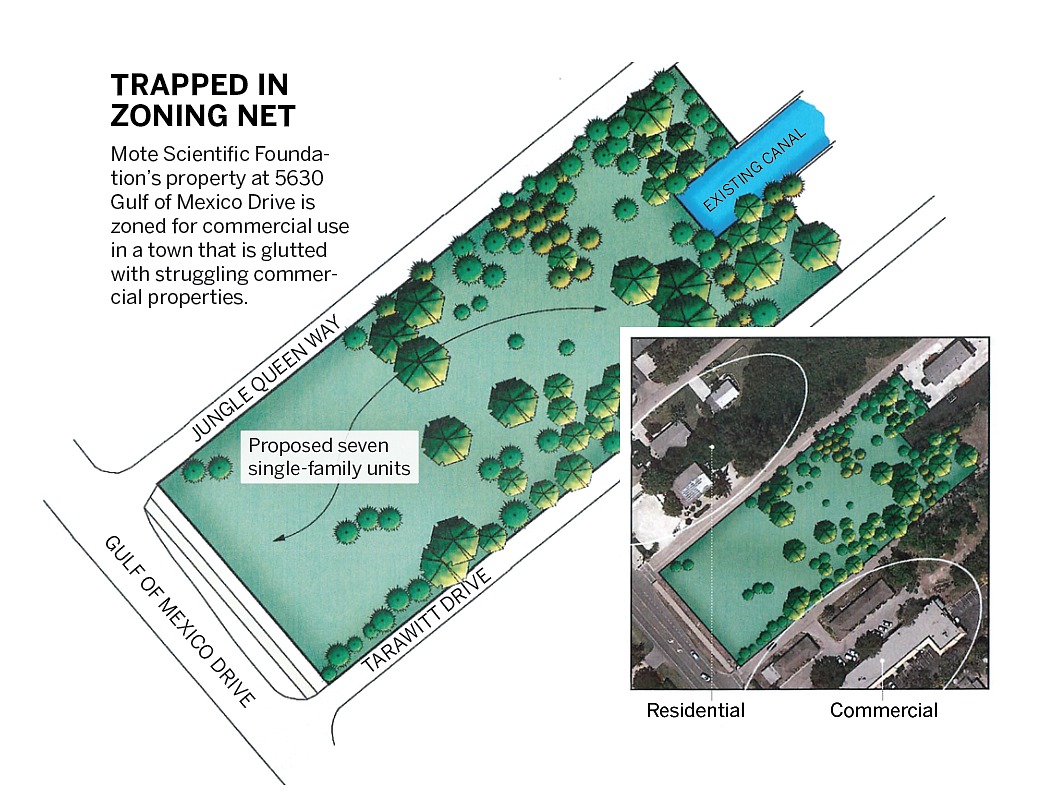- November 23, 2024
-
-
Loading

Loading

Of the two questions on Longboat Key’s March 12 ballot, the second — dubbed “Density Referendum” — should be unequivocal: an unequivocal “yes.”
This question is back on the ballot for a second time, albeit slightly modified.
The first time, in March 2017, it became collateral damage to a more prominent and controversial question on the ballot — Unicorp National Developments’ first proposal to redevelop the former Colony Beach & Tennis Resort.
Many voters may remember at that time Unicorp had proposed redeveloping the Colony at a scale that asked voters to approve adding 180 residential units to the Colony’s 237 units.
Voters responded with a resounding bomb: 87% of the votes cast opposed the additional density.
In the wake of that blast, voters also rejected a second density question. Mote Scientific Foundation asked voters to approve converting its 1.81 acres of vacant property at 5630 Gulf of Mexico Drive from commercial zoning to residential. A developer who was under contract to purchase the property wanted to develop 10 residential units.
Agitated, stoked and mobilized over the Unicorp question — as well as by traffic tie-ups on both ends of the Key during season — 58% of the voters said no to allowing residential development on Mote’s property.
Timing is everything.
Mote is back again. But this time it is requesting approval to convert to residential use at a lower density. It is requesting the same density as the residential properties to its north and east on Jungle Queen Way — four units per acre, or a maximum of seven residential units.
For those voters who are new to the Key and those who need a refresher, in 1984 Longboat voters worried about the Key becoming another Miami Beach. There were discussions then about Longboat being zoned to accommodate a population of 22,000 (today its year-round population is about 7,200).
Alarmed, voters approved a charter referendum that capped the town’s residential density and required voter approval for any increase in density.
Ever since, Longboaters have been extraordinarily protective of holding to current densities. Only two times in the past decade have they approved minor density changes — the former Moore’s Stone Crab site (which is remaining commercial) and a small vacant parcel near the town’s Public Works depot.
One of the unintended consequences of that cap on residential density has been the effects on commercially zoned property. Little did planners realize when they platted the town that the Key would end up with a glut of commercial property.
Now combine that glut with Longboat Key’s highly seasonal population, and you have what exists today: Every retail store and restaurant struggles to avoid losses from June through September. Many businesses make all their profits from October through May and then during the off season lose half or most of what they earned.
On top of this, Longboat has among the most restrictive zoning laws in the region, giving the Key a reputation as an unfriendly place to do business.
All of this combined explains why virtually every commercial area on the Key struggles. It also explains why Longboaters rarely see commercial property owners upgrade their properties. They can’t charge the rents they need to cover their costs without their tenants folding. It’s a vicious circle.
Which brings us to Mote Scientific Foundation’s property. It is caught in this conundrum.
The Mote Foundation goes back to the 1950s, when two New York industrialists, Bill Mote and Ted Bartels, established the Mote-Bartels’ Scientific Foundation Inc. to support their philanthropic activities. In 1965, Mote moved to Longboat Key, and two years later became the namesake, chairman and president of Mote Marine Laboratory.
Over the next 50 years, Mote contributed millions of dollars to his Mote Marine Laboratory and to local not-for-profit organizations and educational institutions. After he died in 2000, the Mote Scientific Foundation continued Mote’s philanthropy (see box).
One of the assets in the foundation has been the 1.8 acres at 5630 Gulf of Mexico Drive. Mote himself purchased it in 1982. After he died, the property was conveyed to the Mote Scientific Foundation.
Over nearly 20 years, the foundation has tried numerous times to sell the vacant lot. But its commercial zoning has been an impediment. The town declined to buy it for park land as well.
Thus, the density referendum.
Now connect the dots.
As long as that property is restricted to commercial use, the likelihood is almost nil of the foundation ever finding a buyer to pay what that property is really worth. What’s more, what good is that property doing the town sitting vacant? It generates no property-tax revenue, nor is it adding value to the community or to its surrounding neighbors. It is benefiting no one.
If voters approve the referendum, there will be many winners: A developer will be able to construct a maximum of seven units, employing contractors to build. The vacant lot, we presume, will become an attractive, productive addition to the town — aesthetically and financially. More property-tax revenue from the new units will mean existing taxpayers will carry less of a burden. Likewise, as residential, the property will have a less-intense use than if it were developed commercially.
But most of all, Mote Scientific Foundation will be able to sell the property and use the proceeds to continue to support local not-for-profits.
We recommend: Vote yes.